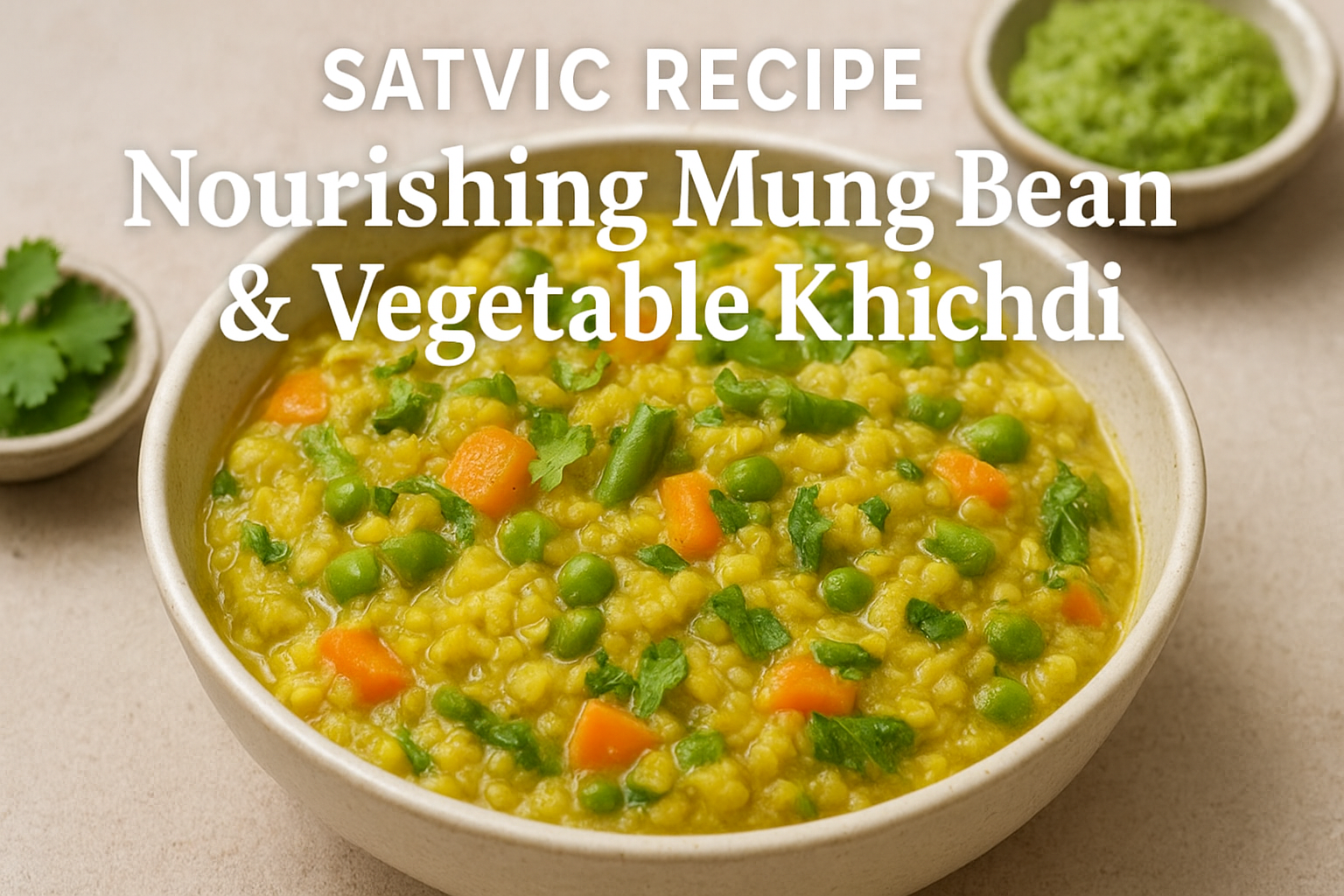Introduction
Food has the power to heal, energize, and transform our lives. According to the Satvic lifestyle, what we eat directly influences our body, mind, and soul. Satvic recipe/ food is fresh, natural, plant-based, and filled with prana (life energy). Among many wholesome recipes, one dish that stands out for its simplicity, purity, and nutrition is the Mung Bean & Vegetable Khichdi.
This recipe is more than just comfort food—it is a healing bowl of wellness. Traditionally used during detox, fasting, or recovery, Khichdi has been cherished in Ayurveda and yogic diets for centuries. It is light on the stomach yet deeply nourishing for the body. Let’s dive into the recipe and understand why this dish is considered Satvic.
Ingredients (Serves 2)
½ cup split yellow mung dal (moong dal)
½ cup unpolished rice (brown rice or red rice works best)
1 ½ cups seasonal vegetables (carrot, beans, peas, bottle gourd, pumpkin, spinach)
1 tsp cumin seeds
1-inch piece ginger (finely chopped or grated)
1-2 curry leaves (optional but Satvic-friendly)
½ tsp turmeric powder
1 tsp rock salt (or pink salt)
4 cups water
1 tsp cold-pressed coconut oil or ghee (optional, use very little)
Fresh coriander leaves for garnish
Method
Wash and soak the mung dal and rice together for at least 30 minutes. Soaking makes it easier to digest.
In a pot or pressure cooker, add the soaked dal-rice mixture with 4 cups of water.
Add turmeric and salt and let it cook until both rice and dal turn soft and mushy.
In a separate pan, lightly sauté cumin seeds, ginger, and curry leaves in a teaspoon of coconut oil or ghee.
Add chopped seasonal vegetables and cook them lightly. Remember, in Satvic cooking we avoid overcooking as it reduces the prana (life force) in food.
Mix the cooked vegetables into the dal-rice mixture. Stir gently to combine.
Garnish with fresh coriander leaves before serving.
Why This Recipe is Satvic?
Satvic food is defined as pure, natural, and energizing. The Mung Bean & Vegetable Khichdi is a perfect representation of this philosophy:
Easily Digestible: Mung beans are light, full of protein, and very gentle on the stomach.
Healing for the Gut: Rice and mung beans together form a complete protein, making it ideal for recovery and cleansing.
Free from Onion & Garlic: These ingredients are avoided in Satvic food as they are considered rajasic and tamasic, which can disturb mental clarity.
Balances Doshas: Ayurveda recommends Khichdi for balancing all three doshas—Vata, Pitta, and Kapha.
Boosts Energy: Instead of weighing you down, it leaves you feeling light and energetic.
Health Benefits of Satvic Khichdi
Supports Digestion – The combination of mung dal and rice is soft, making it soothing for the digestive system.
Detoxifies the Body – Helps flush out toxins and is commonly used during cleansing routines.
Improves Immunity – Fresh seasonal vegetables provide essential vitamins and minerals.
Reduces Stress & Anxiety – Light, pure meals help calm the nervous system and enhance mental clarity.
Balances Weight – Since it is filling yet low in unhealthy fats, it supports natural weight management.
Serving Suggestions
Pair it with a fresh green salad for extra fiber.
Add a bowl of homemade coconut chutney for a tangy twist.
Enjoy with lemon pickle or a squeeze of fresh lime for extra flavor.
For a more cooling meal, serve it with a glass of buttermilk.
Final Thoughts
Mung Bean & Vegetable Khichdi is not just a dish—it is a healing therapy in a bowl. When you choose Satvic food, you choose a lifestyle of balance, harmony, and inner peace. Preparing and eating this recipe mindfully can make you feel lighter, happier, and more connected to yourself.
So next time you crave something simple yet nourishing, try this Satvic Recipe. It will remind you that health doesn’t come from complex diets—it comes from natural, wholesome choices.
Author: Rekha Choudhary
https://deshnewshub.com/

“Hi, I’m Rekha Choudhary — a content writer and yoga instructor. Welcome to my news website, Desh News Hub
, a platform that covers a wide range of categories including health, lifestyle, education, technology, and current affairs. Through my work, I strive to inspire mindful living while keeping readers informed with authentic and insightful updates.”



